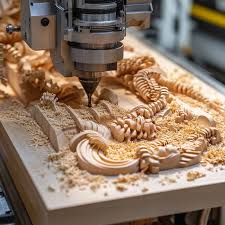Modern craftsmanship is going through a quiet transformation. The rise of CNC (computer numerical control) technology has given woodworkers, metalworkers, and artisans precise tools to shape their ideas. Yet the finest projects still rely on human touch. This marriage of high-tech accuracy with traditional detailing creates results that feel both innovative and timeless. Whether designing furniture, architectural features, or kitchen designs in Indianapolis, this approach honors heritage while embracing the future.
From Workshop to Digital Studio
Years ago, every curve and groove came from hand tools alone. Master artisans trained for decades to carve, fit, and finish each piece. Today, CNC machines have changed how materials are shaped. These machines cut with remarkable consistency, saving time and reducing waste. Designers can program them to create complex patterns or components with exact dimensions.
But while machines can carve, drill, and engrave, they can’t feel grain direction or see how light falls on a finished surface. This is where traditional skills remain essential. Craftspeople refine machine-cut pieces, adjust edges, and add details that no program can fully capture.
- CNC offers speed and precision.
- Handcrafting adds warmth and character.
- Together, they balance efficiency with artistry.
Why Blending Matters
The conversation isn’t about choosing between CNC and handcrafting. It’s about using both in ways that enhance the final product. A fully machine-made item may feel cold or uniform, while purely hand-made work can become inconsistent on large projects. Combining both methods gives designers flexibility.
Picture a custom dining table. A CNC router can cut the tabletop shape, create uniform mortises, or carve intricate inlays. Then, a skilled artisan sands the surface, softens the edges, and applies finishes that highlight the wood’s natural beauty. The outcome feels designed rather than mass-produced, yet it remains cost-effective and structurally sound.
Preserving Craft While Adopting Technology
The fear that technology will erase craftsmanship is understandable but unfounded. In reality, it creates new opportunities for artisans to push boundaries. Instead of spending hours rough-cutting material, they can focus on artistry and personal expression. The hand-detailed elements—like a carved corner on a cabinet or a textured molding—make each project unique.
You can see this in architectural millwork, custom doors, or detailed panels. CNC machines handle the repetitive parts, leaving the artist free to add flourishes and refinements. This division of labor ensures old skills remain alive while allowing shops to meet modern demands for quality and speed.
How Homeowners Benefit
This approach is not only exciting for designers. Homeowners also see the difference. Custom interiors become more affordable and visually distinctive. Wood cabinetry, stone countertops, and specialty furniture feel richer when machine accuracy pairs with human care. The blend creates durable work that holds its value and reflects personal taste.
For example, a family remodeling their kitchen can commission cabinets with CNC-cut frames for flawless fit. Then, an artisan adds subtle detailing by hand, giving the kitchen warmth that feels inviting. The result is precise enough to meet today’s functional needs and beautiful enough to feel crafted for generations.
The Future of Craft and CNC
Looking ahead, new software and tools will make this partnership even stronger. Designers are exploring 3D modeling programs that communicate directly with CNC machines, while traditional artisans are training to integrate these tools into their workflow. What once seemed like opposing worlds are now merging into a single creative process.
Young craftspeople are also learning both skills early. They understand how to code for CNC, but they also value hand tools. This dual knowledge ensures that future work won’t be purely mechanical or purely manual, but a thoughtful blend of both.
Frequently Asked Questions
What is CNC in woodworking?
CNC (computer numerical control) refers to machines programmed to cut, carve, or engrave wood with high precision using digital instructions.
Does CNC replace handcrafting?
No. CNC speeds up repetitive or complex tasks, but hand detailing is still needed for finishing, adjustments, and adding unique character.
Is CNC-assisted furniture considered custom?
Yes. Because designs can be programmed individually, CNC pieces are often custom-made. When combined with hand finishing, they offer both precision and artistry.
Can CNC be used for remodeling projects?
Absolutely. Many contractors use CNC for custom cabinetry, trim, and decorative features in kitchens, bathrooms, and living spaces.
How does this approach impact cost?
By automating certain tasks, CNC reduces labor hours, making high-quality custom work more accessible while maintaining a handcrafted look.
Bringing It All Together
When technology and tradition meet, the result is more than efficient—it’s personal. Homeowners gain unique interiors that balance clean lines with human touch. Designers and artisans enjoy the freedom to focus on creativity rather than only production. Whether you’re commissioning a custom table or exploring kitchen remodeling services near me, blending CNC with hand detailing ensures every piece tells a story—one written in both code and craft.



